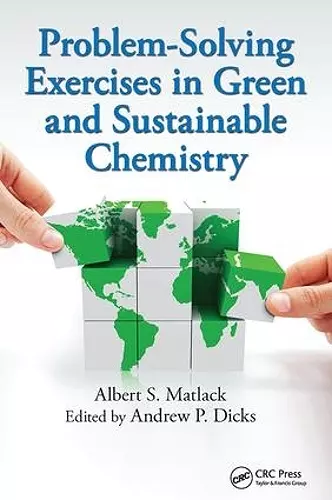Problem-Solving Exercises in Green and Sustainable Chemistry
Format:Hardback
Publisher:Taylor & Francis Ltd
Published:27th Jul '17
Currently unavailable, and unfortunately no date known when it will be back
This hardback is available in another edition too:
- Paperback£39.99(9781482252576)

When confronted with a problem in science, the way to proceed is not always obvious. The problem may seem intractable or there may be many possible solutions, with some better than others. Problem-Solving Exercises in Green and Sustainable Chemistry teaches students how to analyze and solve real-world problems that occur in an environmental context, and it encourages creativity in developing solutions to situations based on events that have actually taken place.
The problems described in this book are relevant and stimulating in learning and understanding the principles of green and sustainable chemistry. They address various aspects of the field, including:
Toxicity
Waste generation and disposal
Chemical accidents
Energy efficiency
New policy development
The final chapter contains proposed solutions to the presented problems and provides commentaries and references to relevant literature.
This book also prompts students to become more comfortable with the idea of multiple "correct" answers to problems. It emphasizes the reality that green chemistry is about making practical decisions and weighing multiple factors that are often conflicting, thus making it difficult or impossible to apply one perfect solution to a given situation. Problem-Solving Exercises in Green and Sustainable Chemistry prepares students to solve challenging problems, whether as green chemists, as architects designing energy-efficient buildings, or as environmentally-conscious citizens.
'"Problem-Solving Exercises in Green and Sustainable Chemistry", by Albert S. Matlack, edited by Andrew P. Dicks, is an excellent book which should be a part of the library of educators who teach the subject, and chemists in general. It is a showcase of problem-based learning, so-called PBL, in which students and other learners are fully engaged in learning via problem solving. Anybody who teaches is well-aware of extra time after the lecture is delivered, when one wishes to have some interesting problems to give to students to work on and discuss. This is a problem particularly in green and sustainable chemistry, which is a new field and not much educational material exists. The author has a gold mine of examples that he has developed over his teaching career, which, significantly, followed his long career in industry. Thus, his examples are rooted in reality, and are quite relevant. Also, they are examples of the evolving issues, rather than something that is solved and set in stone. Thus, these examples are excellent for promoting classroom discussion, and assigning problems to students to research them. General solutions for the problems and useful hints are given in the back of the book. Since the material was developed over a period of years, many references are outdated. However, this minor shortcoming of the book can be easily overcome, since the instructors can either update references themselves, or delegate this task to the students. In conclusion, this unique and valuable book is most highly recommended.'
– Vera M. Kolb, Professor of Chemistry Emeritus, University of Wisconsin-Parkside.
ISBN: 9781138411326
Dimensions: unknown
Weight: 421g
195 pages